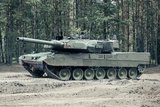Contract moves new Abrams tank forward in the face of cuts
General Dynamics’ AbramsX will inform future development of the M1E3. (Photo: GD)
The US Army awarded General Dynamics Land Systems a US$150 million contract in early July to develop new technologies for the force’s next generation Abrams M1E3 MBT, a positive development at a time when other programmes have suffered.
This work is planned to be completed by June 2027 which means the platform could have an initial operating capability by the early 2030s and a full operational capability by 2040.
The contract is positive move for the programme which survived the recent carnage contained in the transition plan. Notably, plans included a reduction in High-Mobility Multipurpose Wheeled Vehicles, a cut to
Already have an account? Log in
Want to keep reading this article?
More from Land Warfare
-
![Next stage approved for major European robot programme]()
Next stage approved for major European robot programme
The European Commission and Milrem Robotics have signed a grant agreement for iMUGS2, following on from the original iMUGS collaboration to develop modular and scalable architecture for crewed and uncrewed systems.
-
![The British Army’s Land Mobility Programme – all change but no progress?]()
The British Army’s Land Mobility Programme – all change but no progress?
The UK’s Land Mobility Programme, an effort to replace thousands of British Army vehicles, may be about to undergo a radical change in direction.
-
![Supacat and KNDS join forces for British Army vehicle programme]()
Supacat and KNDS join forces for British Army vehicle programme
The Land Mobility Programme is the biggest UK opportunity for the next few decades if it all falls into place. Companies have been filling their dance cards as milestones approach in the hope they are not the mirages of the past.























